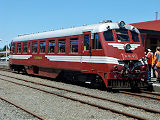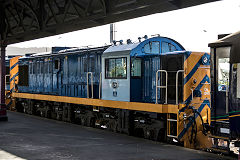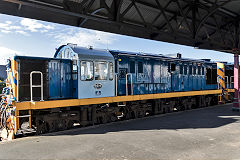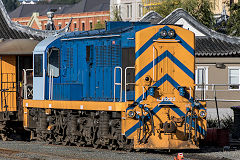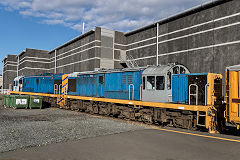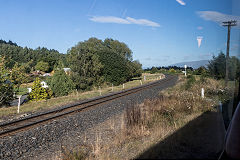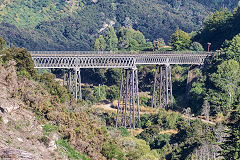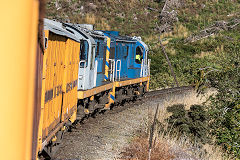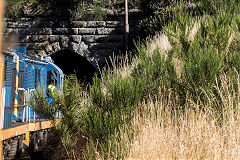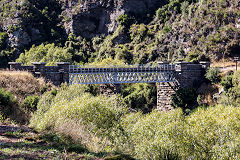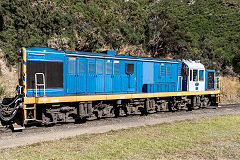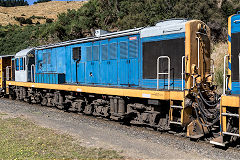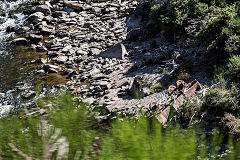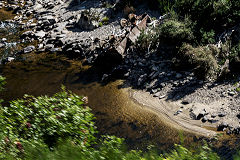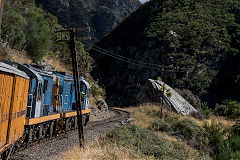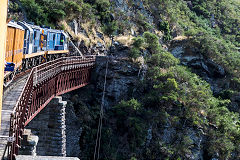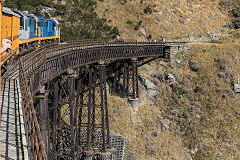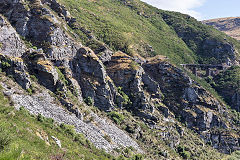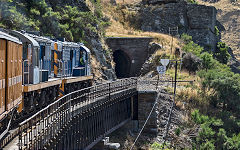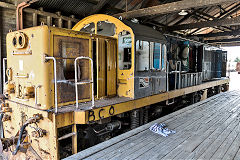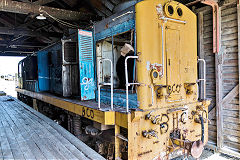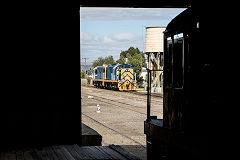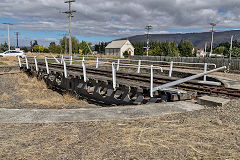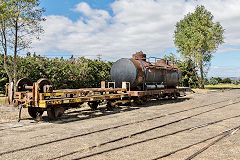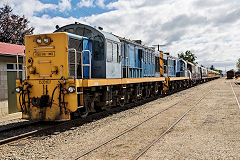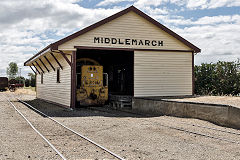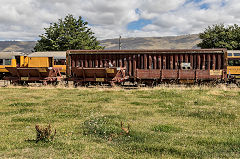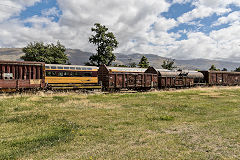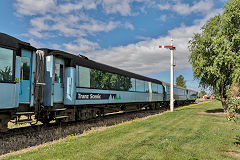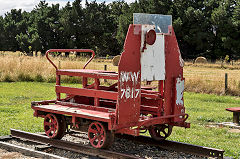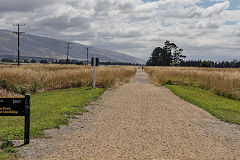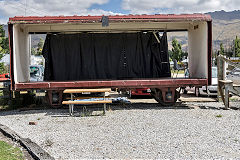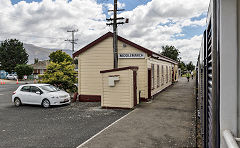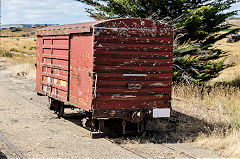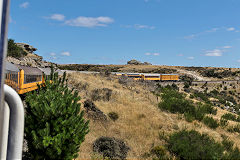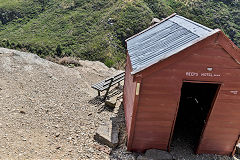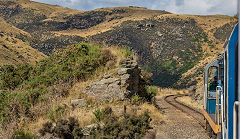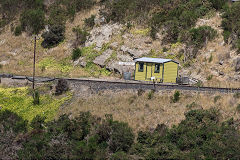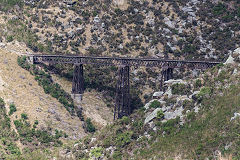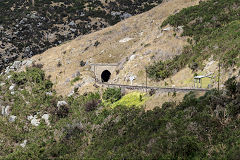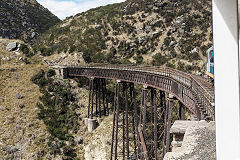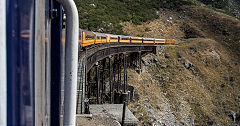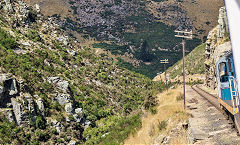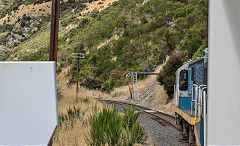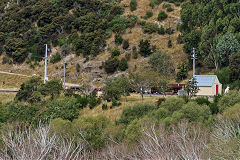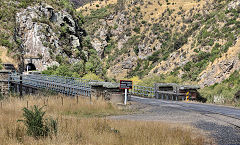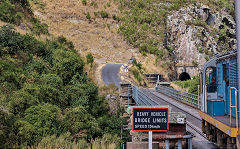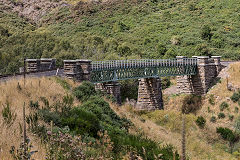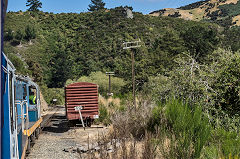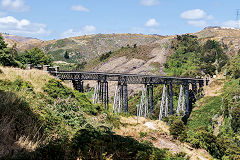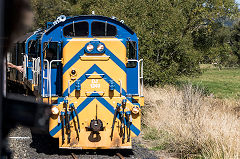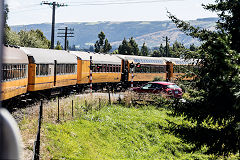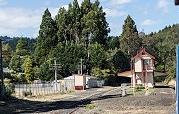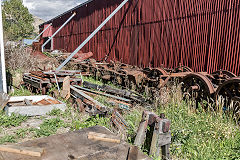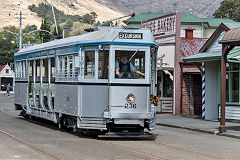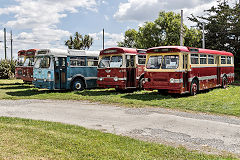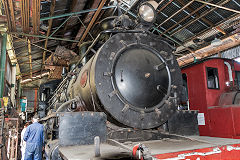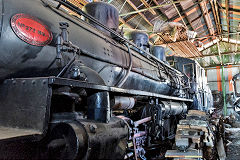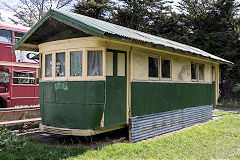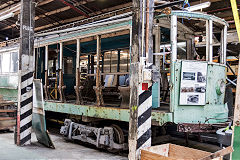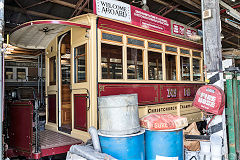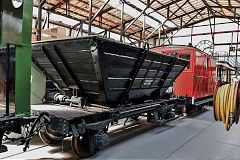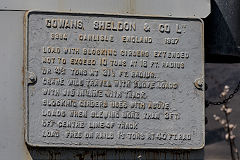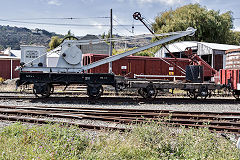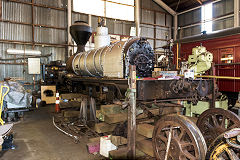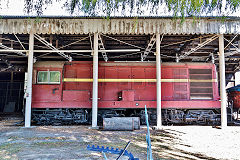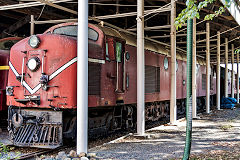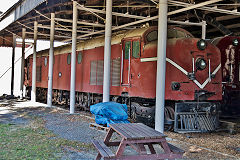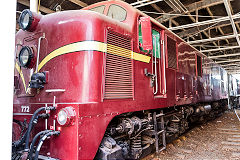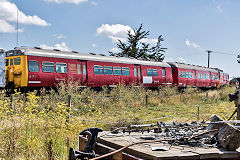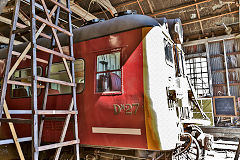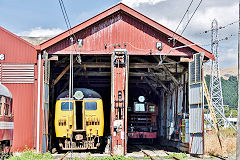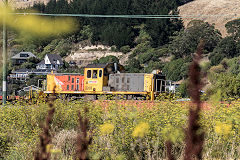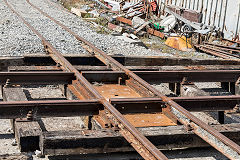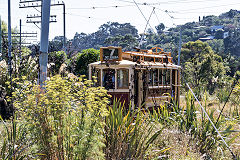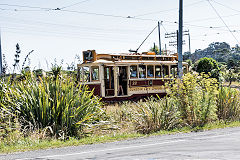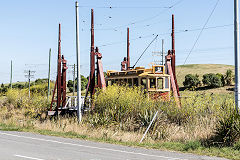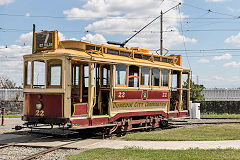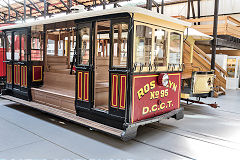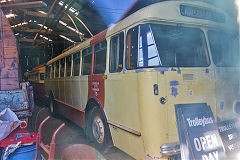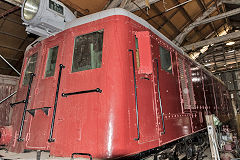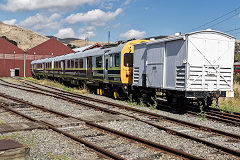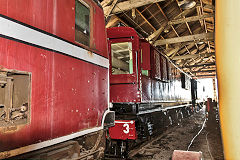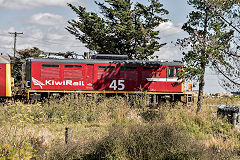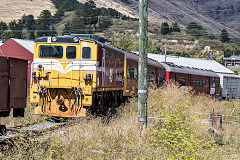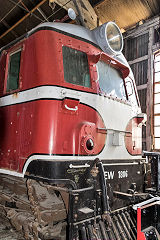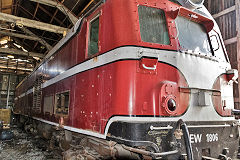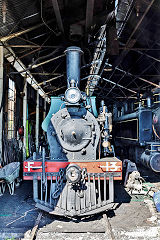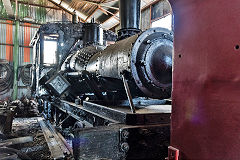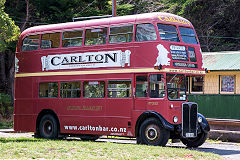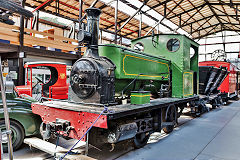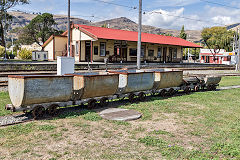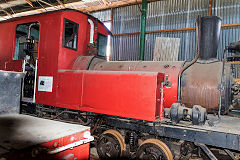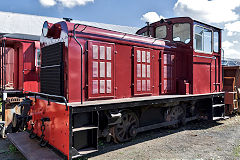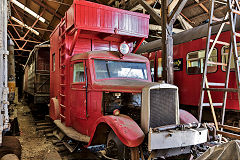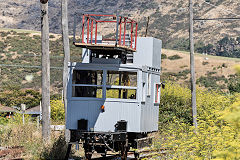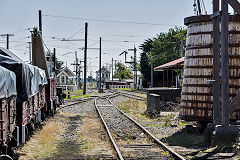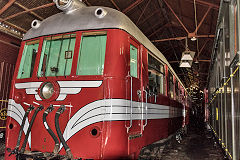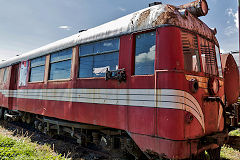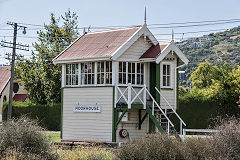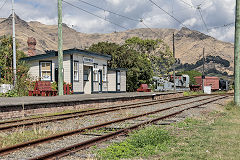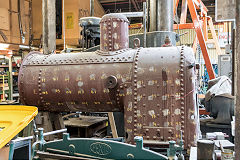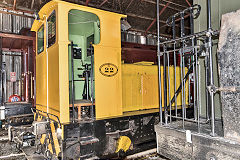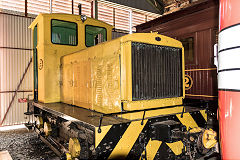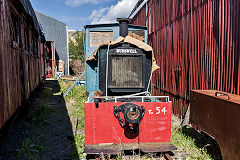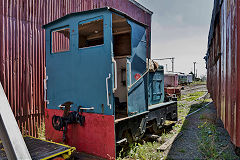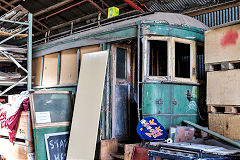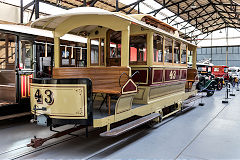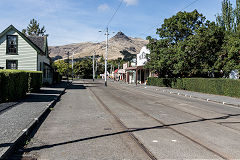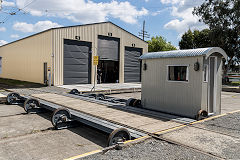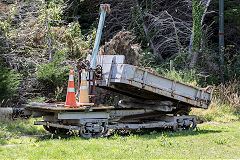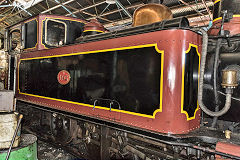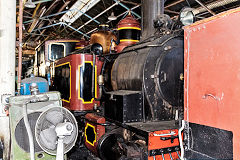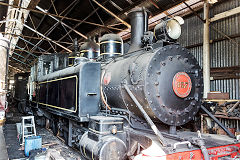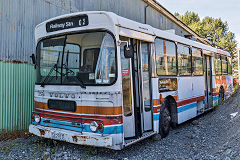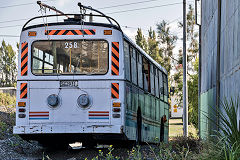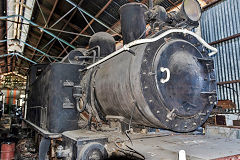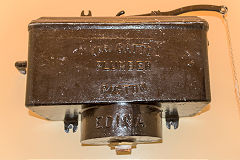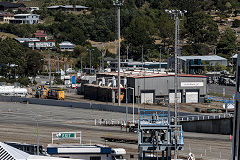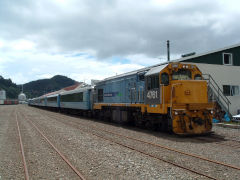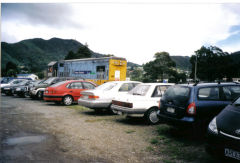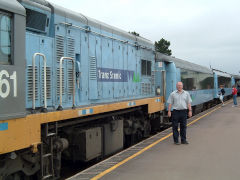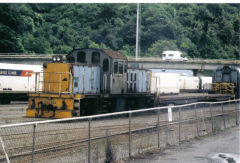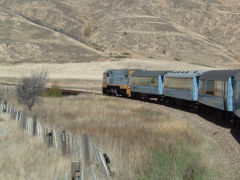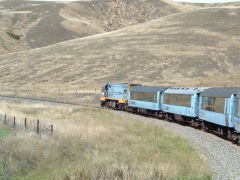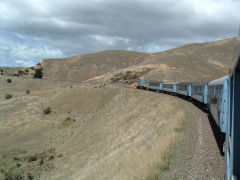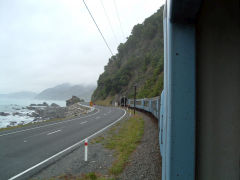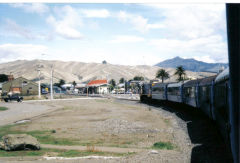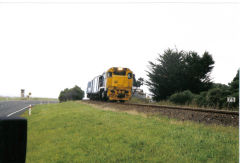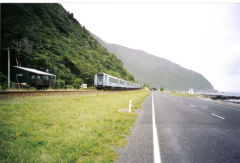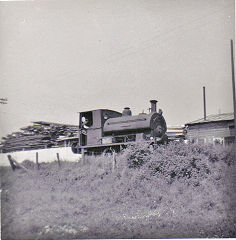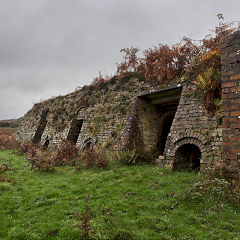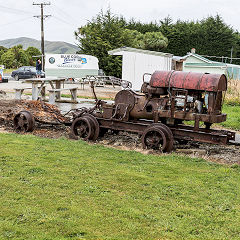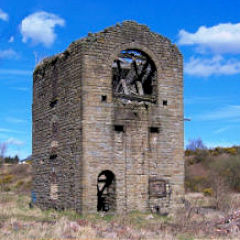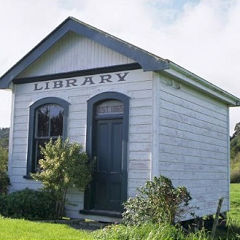The Transport and Industries of New Zealand
Click on the button to go to :-
Click on the thumbnail to enlarge a photo or map and read more about it.
Then click 'Full Size' on the toolbar to see it in all its glory.
Invercargill and Southland
Invercargill and Ohai, Southland
The southern coalfields at Ohai were reached by a branch from Invercargill.
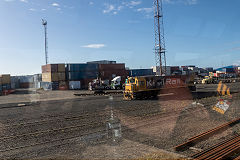
Df 5356, Invercargill
|
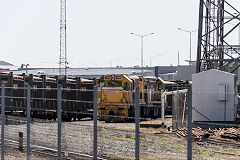
Dfb 7241, Invercargill
|
|
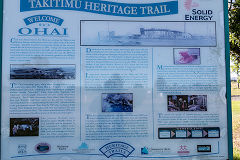
Ohai Coalfield noticeboard
|
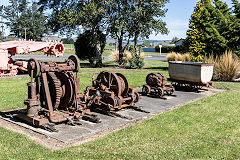
Mining equipment at Ohai
|
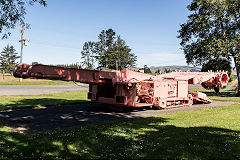
Mining equipment at Ohai
|
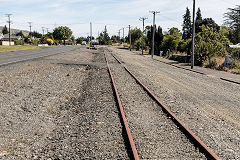
The end of the line, Ohai
|
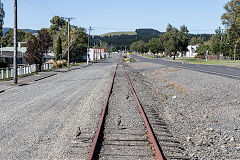
The end of the line, Ohai
|
Riverton, Southland
'Black Maria' once transported logs from Longwoods through the Porakino Valley to sawmills at Riverton. It was built by J. Johnston & Sons foundry, their class 'A', in Invercargill in 1902, retired in 1954 and restored in 2013.

Johnson class A 'Black Maria'
|
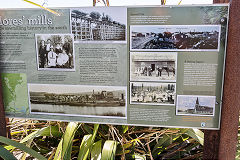
Johnson class A 'Black Maria'
|
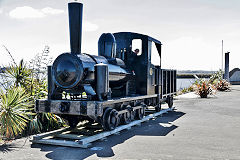
Johnson class A 'Black Maria'
|

Johnson class A 'Black Maria'
|
Tuatapere, Southland
The Tuatapere branch was opened to Riverton in 1879 and reached Tuatapere by 1909. It was extended from Tuatapere to Orawia from 1925 until 1970. In 1976 the Tuatapere Branch was truncated to Riverton.
The logging loco was one of 7 locos of this general design built by H A Melhop of Invercargill.
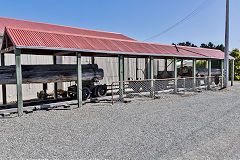
Melhop logging loco, Tuatapere
|
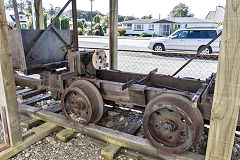
Melhop logging loco, Tuatapere
|
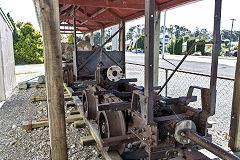
Melhop logging loco, Tuatapere
|
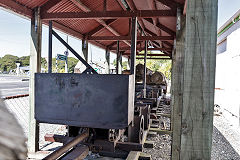
Melhop logging loco, Tuatapere
|
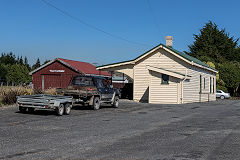
Tuatapere Station
|
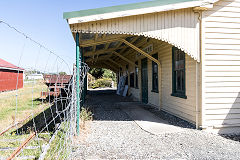
Tuatapere Station
|

Tuatapere Station
|

Tuatapere Station wagon
|
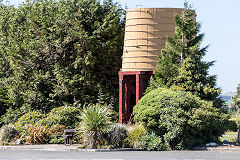
Tuatapere Station water tower
|
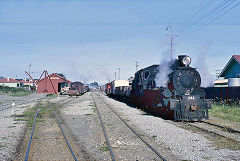
Tuatapere Station, Ab 784, 1966
|
|
|
Waikawa Museum, Catlins
Waikawa Museum has this interesting logging loco parked up outside. Unfortunately I can find no reference to it or anyone who seems to know of it. It may have been built by A & T Burt of Dunedin who took over from Frank Trail, who built 35 locos in the 1920s to 1930s.
Tunnel Hill or Hunts Road Tunnel, Catlins
Tunnel Hill or Hunts Road Tunnel is near Owaka on the Balclutha to Tahakopa railway and was commenced in 1891 using bricks manufactured locally.
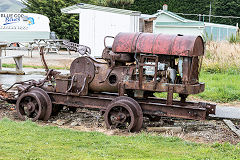
A & T Burt or Traills logging loco
|
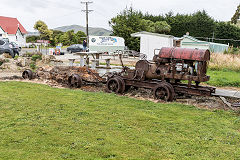
A & T Burt or Traills logging loco
|
|
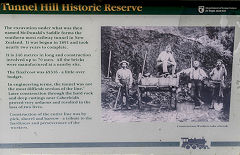
The building of the tunnel
|
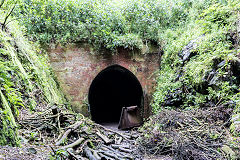
Tunnel Hill North portal
|
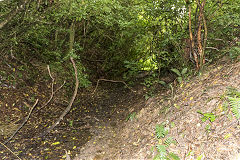
Tunnel Hill North-bound trackbed
|
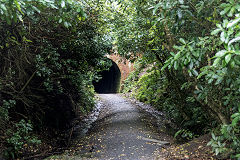
Tunnel Hill South portal
|
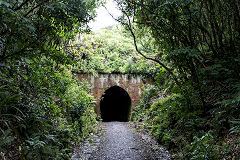
Tunnel Hill South portal
|
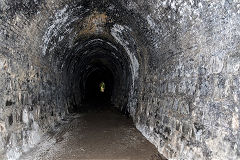
Inside Tunnel Hill
|
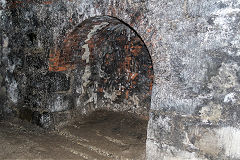
Inside Tunnel Hill
|
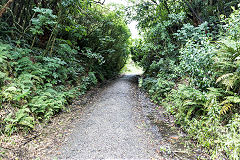
Tunnel Hill South-bound trackbed
|
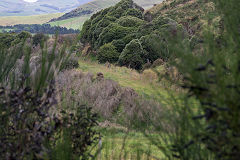
Tunnel Hill South-bound trackbed
|
Dunedin, Queenstown and Otago
Arrowtown
Arrowtown was a vibrant gold-mining town with a population of c7000 in the 1860s. The Arrowtown Chinese Settlement was the home of the many Chinese labourers at that time. The Mace Valley ran up to the goldfields but I didn't have time to explore it very far.
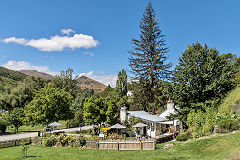
Chinatown, Arrowtown
|
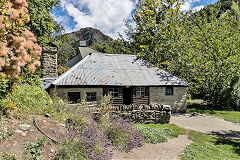
Chinatown, Arrowtown
|
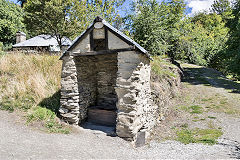
Chinatown, Arrowtown
|
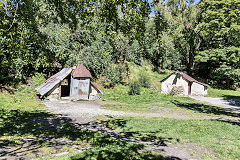
Chinatown, Arrowtown
|
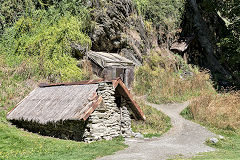
Chinatown, Arrowtown
|
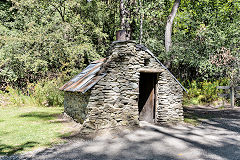
Chinatown, Arrowtown
|
|
|
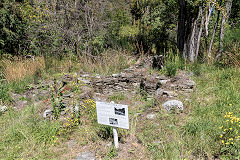
Cooper's Terrace, Mace Valley
|
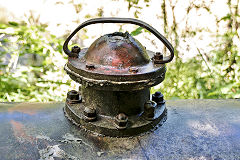
Mace Valley pipeline, Arrowtown
|
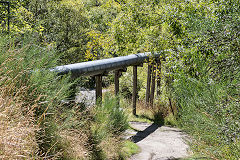
Mace Valley pipeline, Arrowtown
|
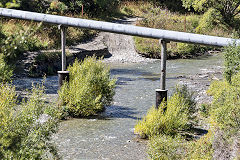
Mace Valley pipeline, Arrowtown
|
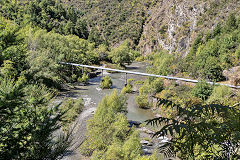
Mace Valley pipeline, Arrowtown
|
|
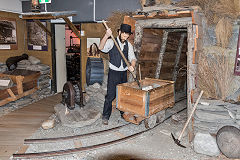
Arrowtown Museum
|
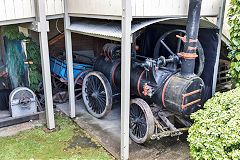
Arrowtown Museum
|
Bluff Fort
Bluff Fort radar station was built in February 1941 and the turntable gear and frame are all that's left. The rangefinder in the observation post could plot the fall of shots within 13kms. A 6inch gun sat in front of the magazine, cleverly hidden inside what appeared to be a wooden bugalow. The camp for the gunners was further up the hill behind the magazine.
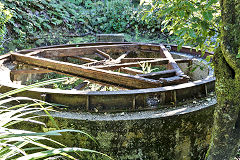
Bluff Fort radar station
|

Bluff Fort radar station
|
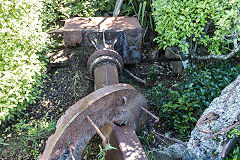
Bluff Fort radar station
|

Bluff Fort obervation post
|
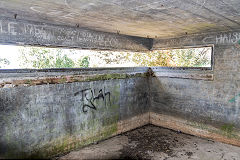
Bluff Fort obervation post
|
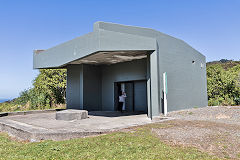
Bluff Fort magazine
|
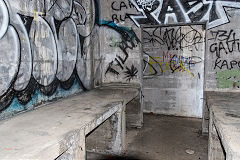
Bluff Fort magazine
|
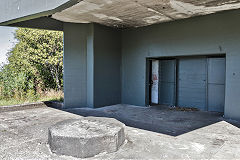
Bluff Fort magazine
|
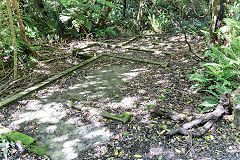
Bluff Fort camp
|
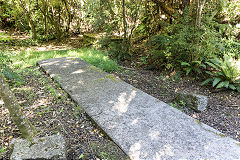
Bluff Fort camp
|

Bluff Fort camp
|
|
Bluff Maritime Museum and other kinds of transport
The Maritime Museum is the home to the oyster boat 'Monica', one of the oldest in the Bluff Oyster fleet, being built in 1909 for Lyttelton owners as the Monica II. She was one of many small steamers working the bays of Banks Peninsula and in 1930 was converted into a fishing boat. She came to Bluff in 1937 for Stewart Island canneries and her steam engines were removed and two 165 bhp diesel engines installed in December 1947.
On the way to Bluff, I passed a loco and some crumbling tramcars near Haywoods. Unfortunately I can find no details of the trams at all, I would have thought someone would know and recorded it.
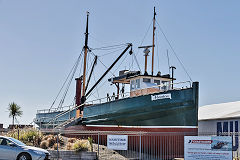
The oyster boat 'Monica'
|
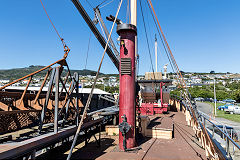
The oyster boat 'Monica'
|
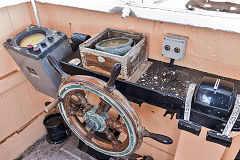
The oyster boat 'Monica'
|
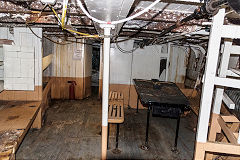
The oyster boat 'Monica'
|
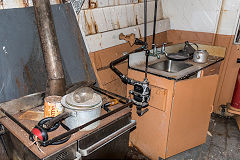
The oyster boat 'Monica'
|
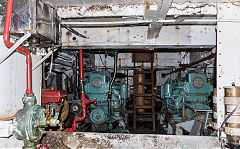
The oyster boat 'Monica'
|
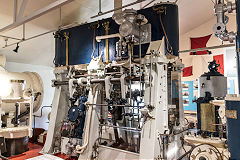
The triple-expansion engine
|
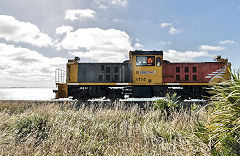
DSG 3114 leaving Bluff
|
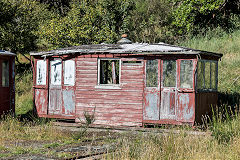
Derelict Dunedin trams
|

Derelict Dunedin trams
|
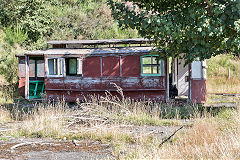
Derelict Dunedin trams
|
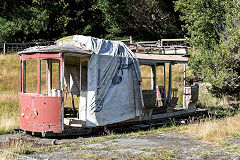
Derelict Dunedin trams
|

Derelict Dunedin trams
|
|
|
|
Dunedin
In and around the station, some difficult-to-photo locomotives at the Settlers Museum and ships that pass in the daytime.
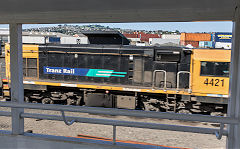
DC 4421 at Dunedin Station
|

DC 4853 at Dunedin Station
|
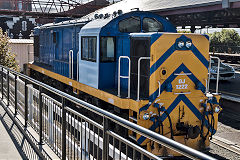
DJ 1227 at Dunedin Station
|
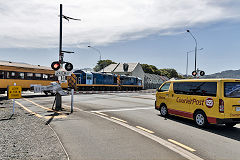
DJs 1240 and 1227 at Dunedin
|
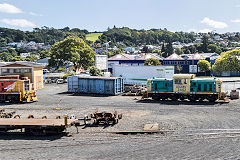
DSC 2464 in Dunedin yard
|
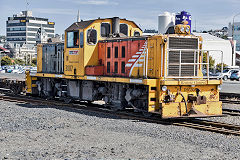
DSG 3087 in Dunedin yard
|
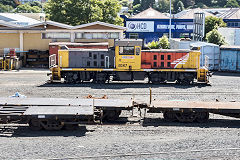
DSG 3087 in Dunedin yard
|
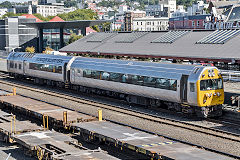
RM 24 at Dunedin Station
|
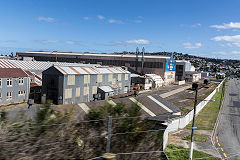
NZR Hillside works, Dunedin
|
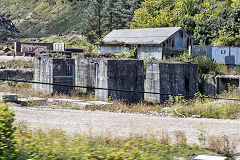
'Milburn Lime and Cement Co Ltd'
|

'Milburn Lime and Cement Co Ltd'
|
|

Ja 1274 at the Settlers Museum
|
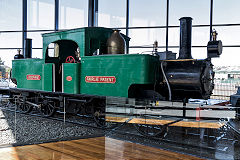
'Joshepine' at the Settlers Museum
|
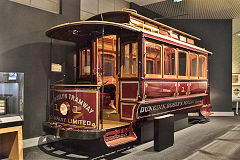
Dunedin tram No 1
|
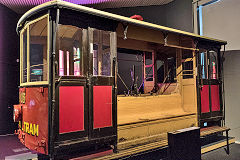
Dunedin tram No 106
|

Dunedin trolleybus No 10
|
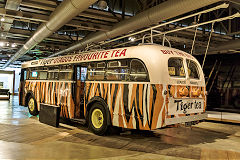
Dunedin trolleybus No 10
|
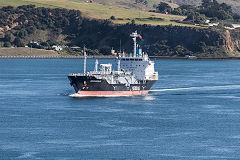
'Bougainville' leaving Dunedin
|
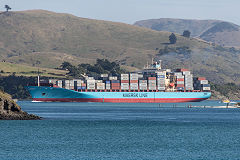
'Lica Maersk' leaving Dunedin
|
Fort Taiaroa, Otago Peninsular
Fort Taiaroa, at the far end of the Otago Peninsular, is now the home of the Royal Albatross Centre. The fort was built in the 1880's during the perceived threat from Tsarist Russia and features a series of underground tunnels leading to the Armstrong disappearing Gun and magazine area. The 6 inch Armstrong Disappearing Gun was installed in May 1889 and is the only one of its kind working and is still in its original gun pit.
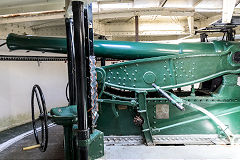
Fort Taiaroa disappearing gun
|
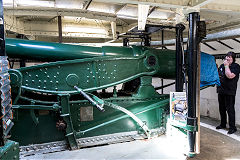
Fort Taiaroa disappearing gun
|
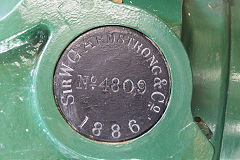
Fort Taiaroa disappearing gun
|
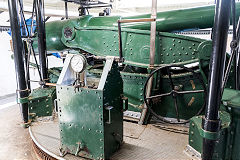
Fort Taiaroa disappearing gun
|
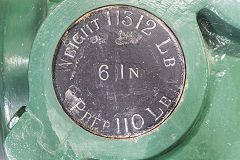
Fort Taiaroa disappearing gun
|
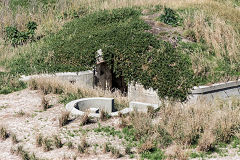
Fort Taiaroa
|
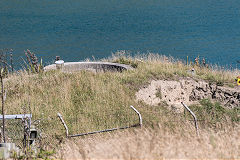
Fort Taiaroa
|
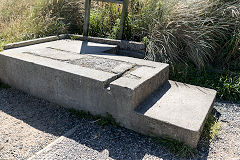
Fort Taiaroa
|
Queenstown, Glenorchy and Lake Wakatipa
An official NZR railway Station but only a short length of hand-operated track. It was connected to the railhead at Kingston and served the gold and Scheelite mines in the hills around Lake Wakatipu. The Invincible Quartz Mining Co was just one of the goldmines, set up in 1879. Scheelite is used for hardening steel and invaluable in wartime so very busy during WW2.
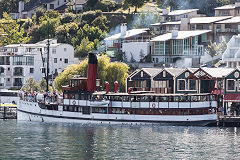
Earnslaw, Lake Wakatipa
|
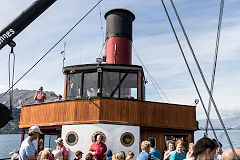
Earnslaw, Lake Wakatipa
|
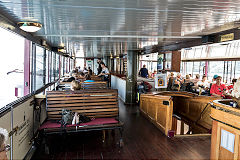
Earnslaw, Lake Wakatipa
|
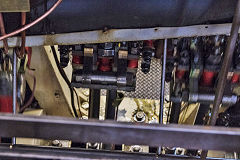
Earnslaw, Lake Wakatipa
|

Earnslaw, Lake Wakatipa
|
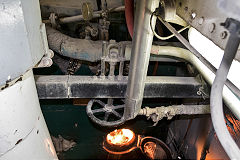
Earnslaw, Lake Wakatipa
|
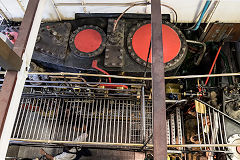
Earnslaw, Lake Wakatipa
|
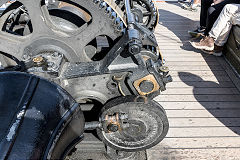
Earnslaw, Lake Wakatipa
|
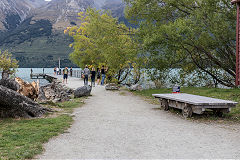
Glenorchy Pier, Lake Wakatipu
|

Glenorchy Pier, Lake Wakatipu
|
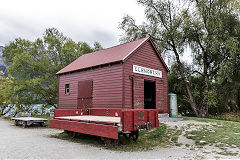
Glenorchy Pier, Lake Wakatipu
|
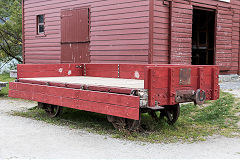
Glenorchy Pier, Lake Wakatipu
|
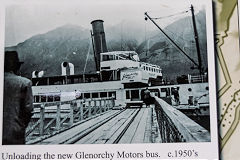
Glenorchy Pier, Lake Wakatipu
|

Mine dram, Glenorchy
|
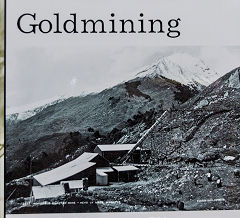
Invincible Quartz Mine
|
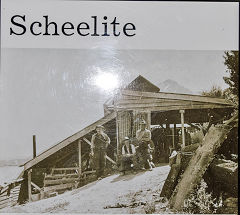
Scheelite Mine, Lake Wakatipu
|
Kingston
The Kingston Flyer ran from Kingston to Fairlight from 1982 to 2012 since when it has not operated. Most of the stock is mothballed at Kingston
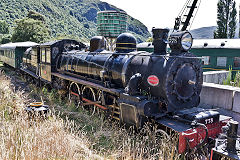
The Kingston Flyer, Ab '778'
|
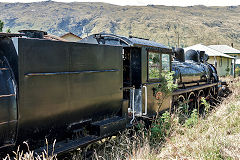
The Kingston Flyer, Ab '785'
|
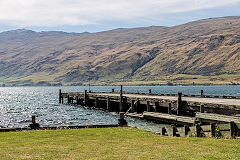
Kingston pier
|
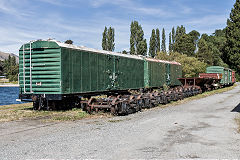
The Kingston Flyer
|
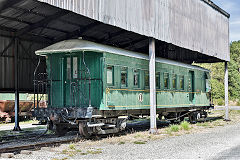
The Kingston Flyer, 'A 1172'
|
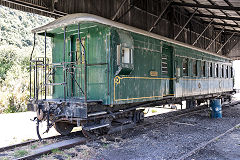
The Kingston Flyer, 'A 1172'
|
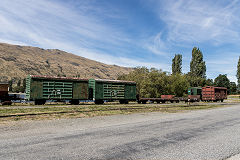
The Kingston Flyer
|
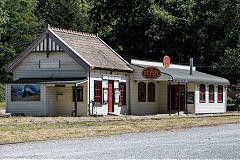
Kingston Station
|
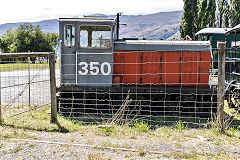
The Kingston Flyer, Tr '350'
|
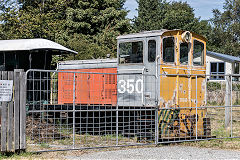
The Kingston Flyer, Tr '350'
|
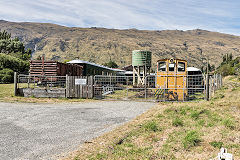
Kingston loco yard
|
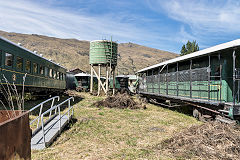
Kingston loco yard
|
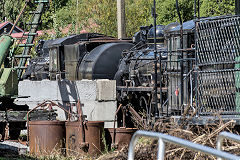
Kingston loco yard and locos
|
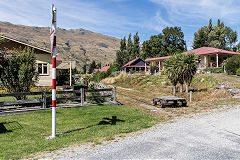
The line leaving Kingston
|
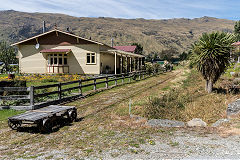
The line leaving Kingston
|
|
Oamaru
Oamaru is home to the Oamaru Steam and Rail Society who operate the Harbourside Railway, the Steampunk Museum and an incredible assortment of old loco ironmongery rescued from the sea when the seawall was rebuilt.
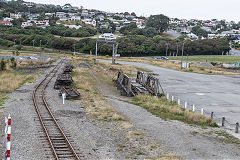
The Harbourside Railway, Oamaru
|
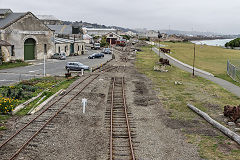
The Harbourside Railway, Oamaru
|
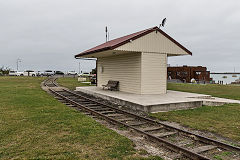
The Harbourside Railway, Oamaru
|
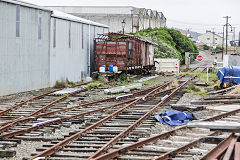
The Harbourside Railway, Oamaru
|
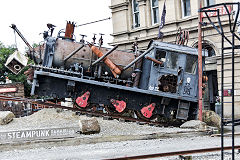
The Steampunk Museum, Oamaru
|
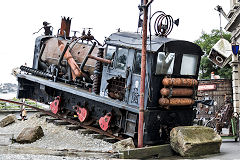
The Steampunk Museum, Oamaru
|
|
|
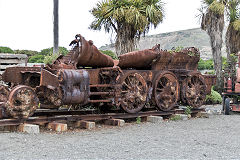
NZR Uc 366 at Oamaru
|
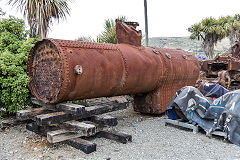
More ironmongery at Oamaru
|
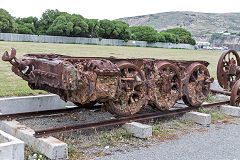
More ironmongery at Oamaru
|
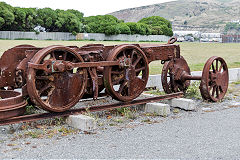
More ironmongery at Oamaru
|
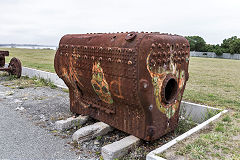
More ironmongery at Oamaru
|
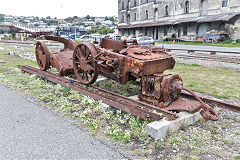
More ironmongery at Oamaru
|

More ironmongery at Oamaru
|
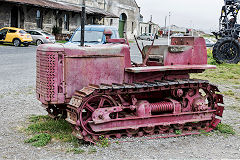
Unidentified tractor at Oamaru
|
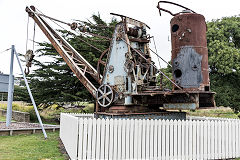
Stothert and Pitt steam crane
|
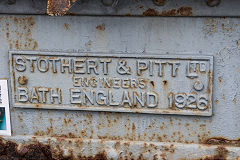
Stothert and Pitt steam crane
|
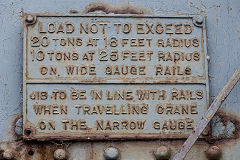
Stothert and Pitt steam crane
|
|
Sandymount Limekilns, Otago Peninsular
Limekilns seem very few and far between in New Zealand. These are the only ones I came across. They date from 1874 and were ultimately owned by the 'Milburn Lime and Cement Co Ltd' who donated them to the 'Otago Peninsular Trust' in 1976
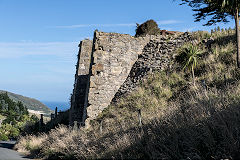
Upper kiln, Sandymount
|
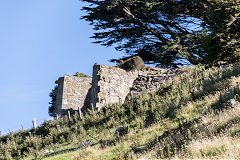
Upper kiln, Sandymount
|
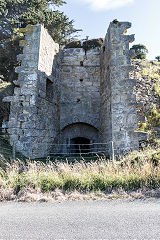
Upper kiln, Sandymount
|

Upper kiln, Sandymount
|
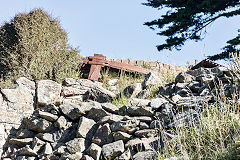
Upper kiln, Sandymount
|
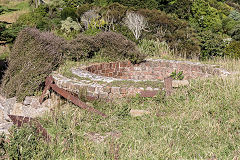
Upper kiln, Sandymount
|
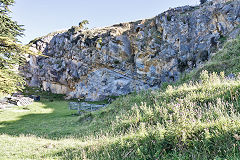
Sandymount Quarry
|

Lower kiln, Sandymount
|

Lower kiln, Sandymount
|
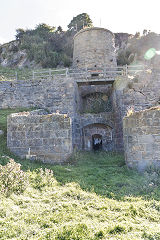
Lower kiln, Sandymount
|
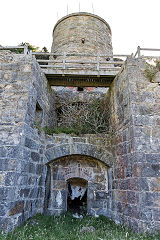
Lower kiln, Sandymount
|
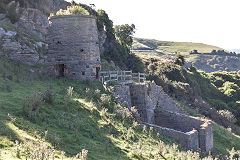
Lower kiln, Sandymount
|
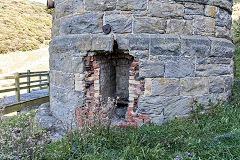
Lower kiln, Sandymount
|
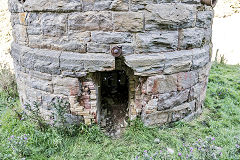
Lower kiln, Sandymount
|
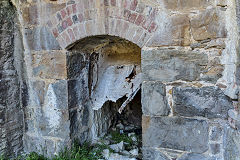
Lower kiln, Sandymount
|
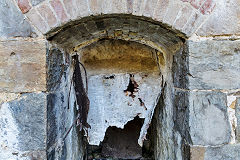
Lower kiln, Sandymount
|
Christchurch and Canterbury
Arthurs Pass
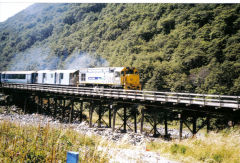
Arthurs Pass, DCP 4559
|
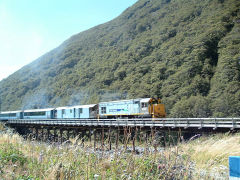
Arthurs Pass, DCP 4559
|

Arthurs Pass, DCP 4559
|
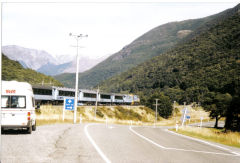
Arthurs Pass, DCP 4559
|
Christchurch City
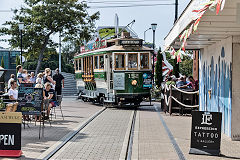
Christchurch tram '152'
|
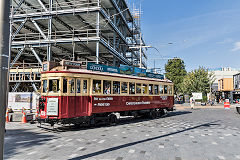
Christchurch tram '178'
|

Christchurch Tramway
|
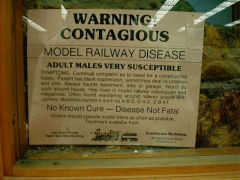
Model Railway Disease
|
Around Canterbury
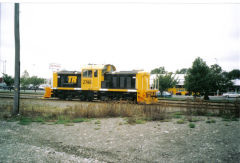
Ashburton, DSC 2746
|
|
|
|
The Little River Branch
On my first visit to NZ in 2004 one of the family took my photo on the SIMT at Dunsandel as you do... I didn't know until much later that it was a junction of one of the Canterbury branchlines. Last year I found myself at Little River, the terminus of one of these branchlines, open from 1886 to 1962. It now forms part of 'the Little River Rail Trail', a great walking route.
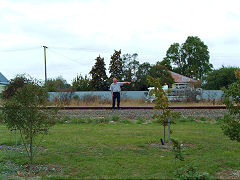
SIMT at Dunsandel, Canterbury
|
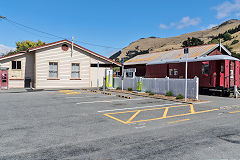
Little River Station
|

Little River Station
|
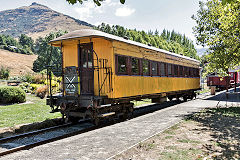
Little River Station
|
Waipara and the Weka Pass Railway,
A fortuitous conducted tour in 2017 as when I stopped the yard was deserted, then suddenly one of the members arrived and very kindly showed me around. Followed by a fleeting glimpse while passing on the Picton-Christchurch train in 2004.
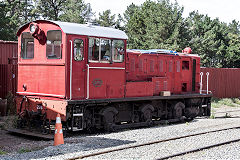
'DSA 276' at the WPR
|
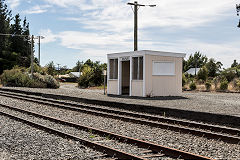
Waipara Station
|
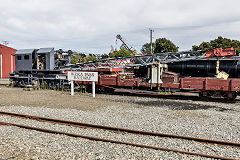
Weka Pass Railway yard
|
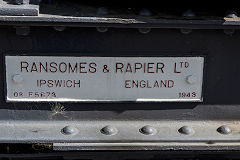
Weka Pass Railway yard
|
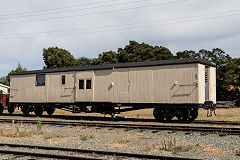
Weka Pass Railway yard
|
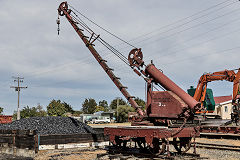
Weka Pass Railway yard
|
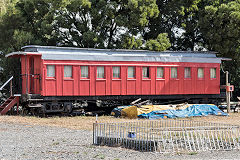
Weka Pass Railway yard
|
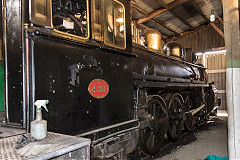
'A428', Weka Pass Railway
|

'DE 1429', Weka Pass Railway
|
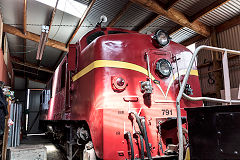
'DG 791', Weka Pass Railway
|
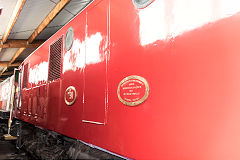
'DG 791', Weka Pass Railway
|
|

Weka Pass Railway, 'DSA 276'
|
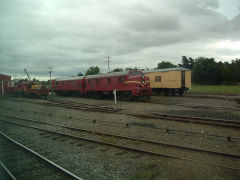
'DG 770' and 'DG 791'
|
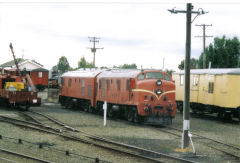
'DG 770' and 'DG 791'
|

Weka Pass Railway, 'DG 783'
|
